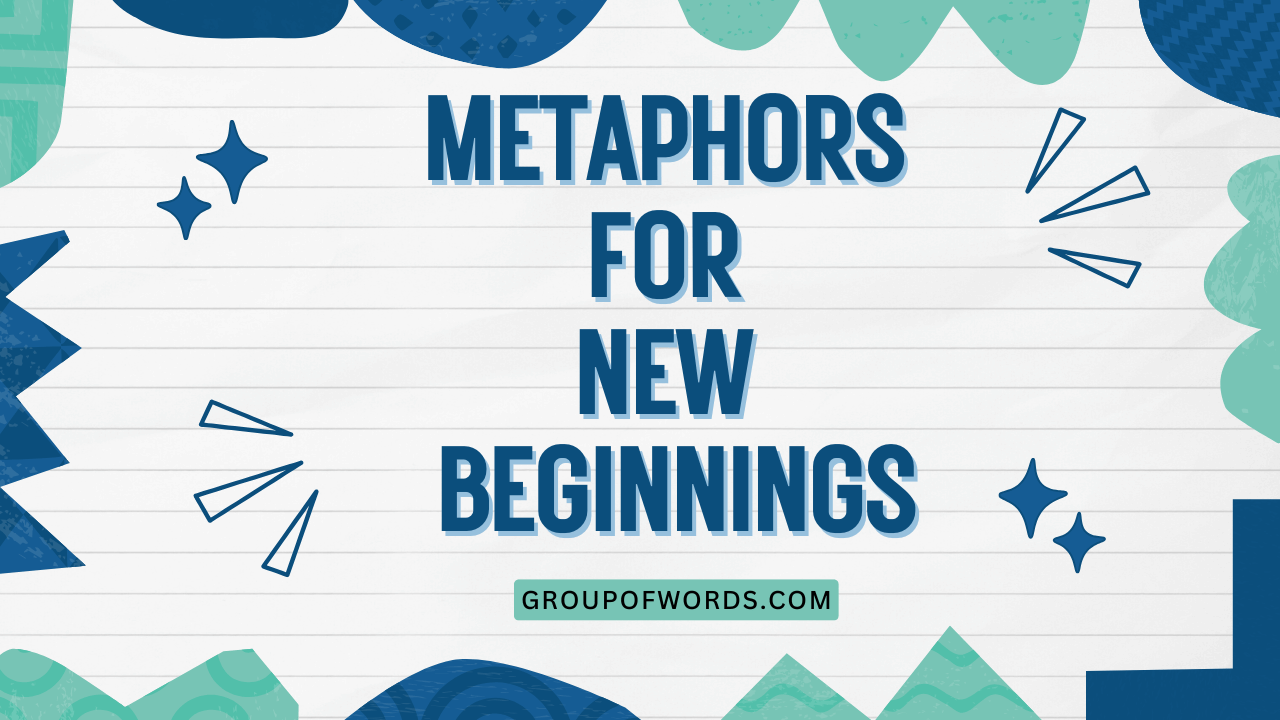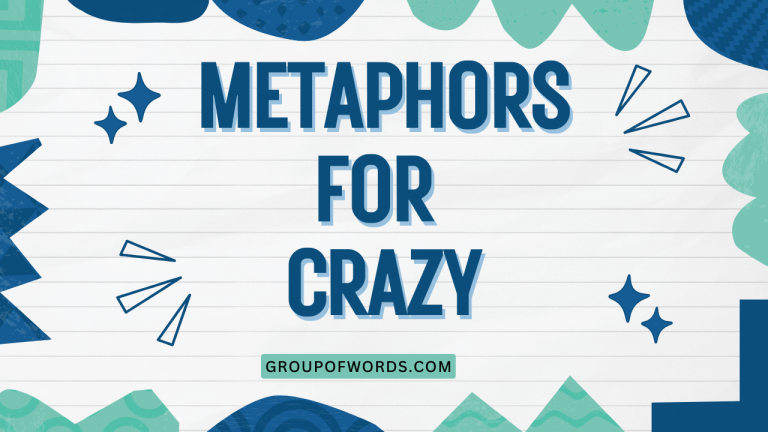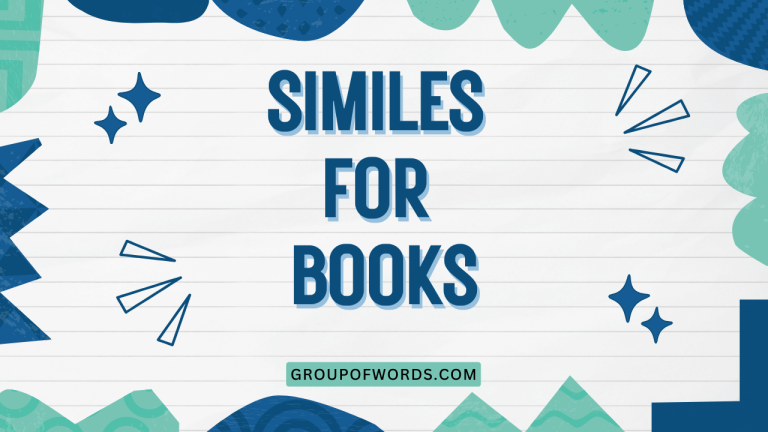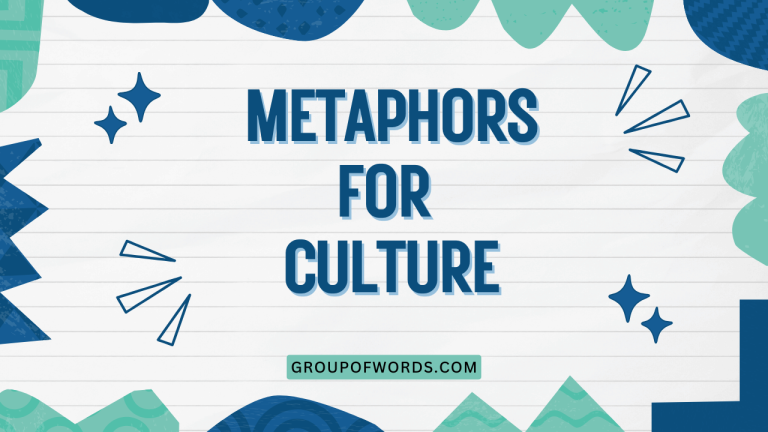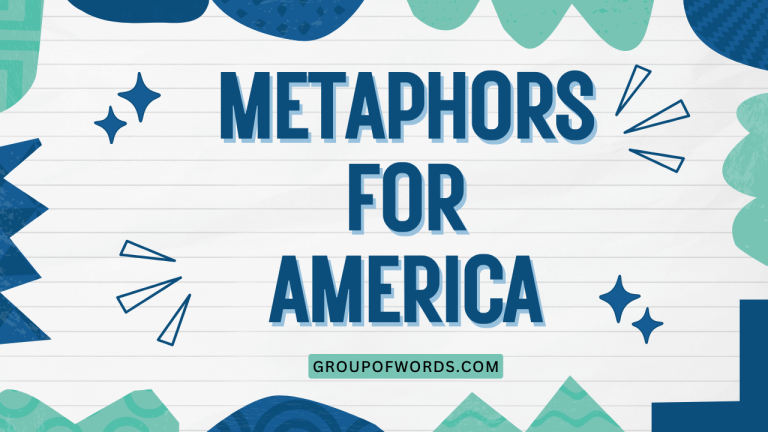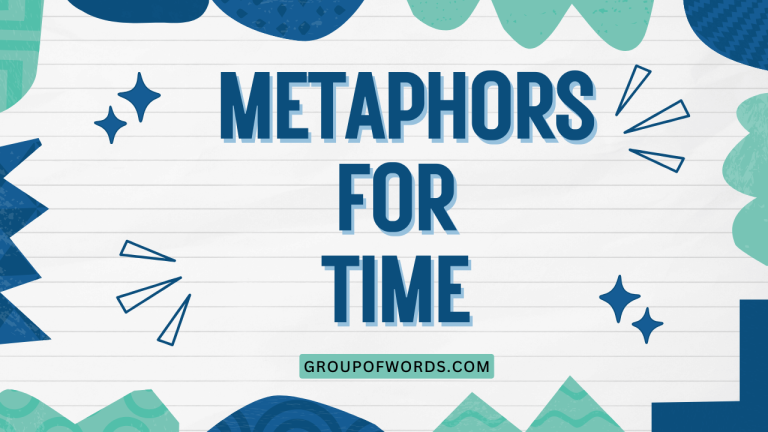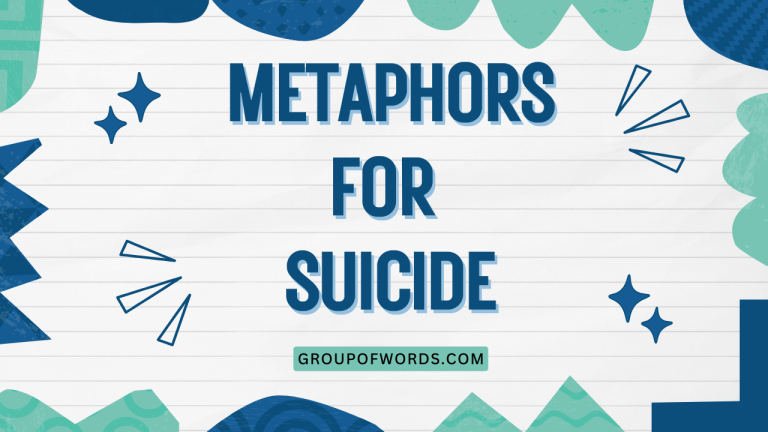Metaphors for New Beginnings: A Grammatical Guide
Metaphors are powerful tools in the English language, allowing us to convey complex ideas and emotions in a vivid and relatable way. When it comes to the concept of “new beginnings,” metaphors become particularly effective, painting a picture of hope, opportunity, and transformation.
Understanding how these metaphors function grammatically enhances our ability to both interpret and use them effectively. This article delves into the grammar of metaphors for new beginnings, exploring their structure, types, and usage, benefiting students, writers, and anyone looking to enrich their understanding of English.
This comprehensive guide will equip you with the knowledge to identify, analyze, and employ metaphors related to new beginnings with confidence and precision, making your communication more impactful and nuanced.
Table of Contents
- Introduction
- Definition of Metaphor and New Beginnings
- Classification of Metaphors
- Function of Metaphors
- Contexts for Using New Beginning Metaphors
- Structural Breakdown of New Beginning Metaphors
- Source Domain
- Target Domain
- Mapping
- Types and Categories of New Beginning Metaphors
- Journey Metaphors
- Growth Metaphors
- Cleansing Metaphors
- Light Metaphors
- Construction Metaphors
- Examples of New Beginning Metaphors
- Journey Metaphor Examples
- Growth Metaphor Examples
- Cleansing Metaphor Examples
- Light Metaphor Examples
- Construction Metaphor Examples
- Usage Rules for New Beginning Metaphors
- Appropriateness and Context
- Clarity and Relevance
- Avoiding Clichés
- Common Mistakes with New Beginning Metaphors
- Mixed Metaphors
- Overused Metaphors
- Practice Exercises
- Exercise 1: Identifying Metaphors
- Exercise 2: Creating Metaphors
- Exercise 3: Analyzing Metaphors
- Advanced Topics in Metaphor Usage
- Extended Metaphors
- Dead Metaphors
- Conceptual Metaphors
- Frequently Asked Questions
- Conclusion
Definition of Metaphor and New Beginnings
A metaphor is a figure of speech that directly compares two unrelated things, asserting that one thing *is* the other, not literally, but for rhetorical effect. It’s a way of understanding and experiencing one kind of thing in terms of another. This comparison is implicit, unlike a simile, which uses “like” or “as” to make the comparison explicit.
A “new beginning” refers to a fresh start, a chance to move forward from a previous state or situation. It often implies a sense of hope, renewal, and opportunity.
Metaphors for new beginnings are used to describe this transition in evocative and imaginative ways.
Classification of Metaphors
Metaphors can be classified in several ways, including:
- Standard Metaphors: Common and easily understood metaphors (e.g., “time is money”).
- Novel Metaphors: Original and creative metaphors that offer a fresh perspective.
- Dead Metaphors: Metaphors that have become so common that they’re no longer recognized as metaphors (e.g., “the leg of a table”).
- Mixed Metaphors: Incongruous metaphors that combine unrelated images (often unintentionally humorous).
Function of Metaphors
Metaphors serve several important functions in language:
- Explanation: They can simplify complex concepts by relating them to something familiar.
- Emphasis: They can add emotional impact and make writing more vivid.
- Persuasion: They can influence an audience’s perception by framing an issue in a particular way.
- Creativity: They allow for imaginative expression and artistic flair.
Contexts for Using New Beginning Metaphors
Metaphors for new beginnings are commonly used in various contexts:
- Literature: To enhance themes of rebirth, transformation, and hope.
- Speeches: To inspire and motivate audiences during times of change.
- Personal Writing: To reflect on personal growth and life transitions.
- Everyday Conversation: To express feelings about new opportunities and experiences.
Structural Breakdown of New Beginning Metaphors
Understanding the structure of a metaphor helps in analyzing its meaning and effectiveness. A metaphor typically consists of two main components: the source domain and the target domain.
Source Domain
The source domain is the concept or idea that is used to understand the target domain. It’s the familiar or concrete concept that lends its characteristics to the less familiar or abstract one. In the context of new beginning metaphors, the source domain could be journeys, growth, cleansing, light, or construction.
Target Domain
The target domain is the concept or idea that is being explained or understood through the metaphor. In the case of new beginning metaphors, the target domain is always the “new beginning” itself – the fresh start, the opportunity for change.
Mapping
Mapping refers to the process of connecting elements from the source domain to corresponding elements in the target domain. This is how the metaphor creates meaning. For instance, if “new beginnings” are described as a “clean slate,” the mapping involves associating the blankness and potential of a slate with the possibilities of a fresh start.
For example, in the metaphor “Life is a blank canvas,” the source domain is “blank canvas,” and the target domain is “life.” The mapping involves associating the potential and creative possibilities of a blank canvas with the opportunities and experiences that life offers.
Types and Categories of New Beginning Metaphors
New beginning metaphors can be categorized based on the source domain they draw from. Here are some common categories:
Journey Metaphors
These metaphors frame new beginnings as a journey, emphasizing the path forward, challenges, and potential destinations. They often involve concepts like roads, maps, and exploration.
These metaphors often highlight the process of change and the effort required to navigate new situations. The journey metaphor emphasizes progress, direction, and the overcoming of obstacles.
Growth Metaphors
Growth metaphors use the imagery of plants and seeds to represent new beginnings. They highlight the potential for development, nurturing, and blossoming.
These metaphors underscore the idea that new beginnings require time, care, and the right conditions to flourish. They can convey the idea of gradual improvement and the realization of potential.
Cleansing Metaphors
These metaphors associate new beginnings with purification and removal of the old. They often involve imagery of washing, cleaning, and clearing away obstacles.
Cleansing metaphors suggest a fresh start by eliminating past mistakes or negative influences. These metaphors create a sense of renewal and liberation.
Light Metaphors
Light metaphors use the imagery of light and darkness to represent new beginnings. Light symbolizes hope, clarity, and understanding, while darkness represents the past or uncertainty.
These metaphors emphasize the illuminating and positive aspects of new opportunities. Light metaphors can convey a sense of optimism and guidance.
Construction Metaphors
Construction metaphors describe new beginnings as building or creating something new. They often involve imagery of foundations, blueprints, and structures.
These metaphors highlight the effort, planning, and creativity involved in starting something new. Construction metaphors suggest a sense of purpose and the potential for lasting achievement.
Examples of New Beginning Metaphors
Here are several examples of new beginning metaphors, organized by category.
Journey Metaphor Examples
The following table illustrates different journey metaphors used to describe new beginnings. Each example highlights the idea of progress, direction, and overcoming obstacles.
| Metaphor | Explanation |
|---|---|
| “Starting a new chapter” | Implies that life is a book, and a new beginning is like turning to a fresh page. |
| “Embarking on a new adventure” | Suggests that a new beginning is an exciting and potentially challenging journey. |
| “Setting sail on uncharted waters” | Conveys the idea of exploring unknown possibilities and taking risks. |
| “Turning a corner” | Indicates a significant change in direction or circumstances. |
| “Blazing a new trail” | Implies innovation and pioneering spirit in a new endeavor. |
| “At the crossroads” | Describes a moment of decision where a new path must be chosen. |
| “Navigating a new course” | Suggests careful planning and strategic action in a new direction. |
| “Climbing a new mountain” | Emphasizes the challenges and effort required to achieve a new goal. |
| “Stepping onto a new path” | Implies a conscious decision to move forward in a different direction. |
| “On the road to recovery” | Describes the process of healing and moving forward from a difficult experience. |
| “A new route to success” | Suggests an alternative approach to achieving a desired outcome. |
| “Mapping out a new future” | Implies careful planning and vision for what lies ahead. |
| “Crossing the bridge to a better life” | Conveys the idea of leaving the past behind and moving towards a more positive future. |
| “Taking the first step” | Highlights the initial action required to start a new endeavor. |
| “Leaving port” | Suggests a departure from the familiar and a venture into the unknown. |
| “Finding a new horizon” | Implies discovering new possibilities and perspectives. |
| “The next leg of the journey” | Describes a continuation of progress towards a long-term goal. |
| “A fresh itinerary” | Suggests a new plan or schedule for achieving desired outcomes. |
| “Wandering into a new world” | Conveys a sense of exploration and discovery in a new environment. |
| “Piloting a new venture” | Implies leadership and direction in a new business or project. |
| “Changing lanes” | Suggests altering one’s approach or strategy to achieve a different or better outcome. |
| “Switching gears” | Implies adapting to a new situation or challenge with renewed energy. |
| “A different destination” | Suggests a change in goals or aspirations, requiring a new approach. |
| “Following a new star” | Implies being guided by a new source of inspiration or ambition. |
| “Riding a new wave” | Suggests capitalizing on a new trend or opportunity. |
Growth Metaphor Examples
The following table showcases growth metaphors used to describe new beginnings. These examples emphasize the potential for development, nurturing, and blossoming.
| Metaphor | Explanation |
|---|---|
| “Planting a seed” | Suggests that a new beginning is like planting a seed, requiring time and care to grow. |
| “Turning over a new leaf” | Implies a fresh start and a commitment to positive change. |
| “Blooming into something new” | Conveys the idea of flourishing and reaching full potential. |
| “Sprouting from the ground up” | Indicates a new beginning that starts from the very beginning. |
| “A fertile ground for innovation” | Suggests that a new environment is conducive to new ideas and development. |
| “Rooting for change” | Implies supporting and encouraging a new beginning to take hold. |
| “The dawn of a new era” | Suggests the start of a significant period of growth and progress. |
| “Reaping the rewards of hard work” | Implies that a new beginning will yield positive results through effort. |
| “A budding talent” | Describes a potential that is just starting to develop. |
| “A blossoming friendship” | Conveys the idea of a new relationship that is growing stronger. |
| “Cultivating new skills” | Suggests the process of developing and refining new abilities. |
| “A growing opportunity” | Implies that a new beginning is expanding and becoming more promising. |
| “The seeds of change” | Conveys the idea that new beginnings are planted with the intention of future transformation. |
| “Nurturing a dream” | Suggests providing the care and attention needed for a new beginning to succeed. |
| “The fruits of labor” | Implies that a new beginning will produce positive outcomes through hard work. |
| “A fresh bloom” | Suggests that something beautiful and new is emerging. |
| “A green shoot of hope” | Implies a small but promising sign of positive change. |
| “The garden of opportunity” | Conveys the idea that a new beginning offers many possibilities. |
| “A fertile imagination” | Suggests that a new beginning is fueled by creativity and innovative thinking. |
| “The roots of success” | Implies that a new beginning is built on a strong foundation. |
| “A sprout of innovation” | Suggests that a new idea or approach is beginning to emerge and develop. |
| “Budding entrepreneurs” | Implies individuals who are just starting their journey in the business world with potential for growth. |
| “The blossoming of creativity” | Conveys the idea of artistic expression and innovation reaching its full potential. |
| “Cultivating new relationships” | Suggests the careful and intentional development of meaningful connections. |
| “Seeding new ideas” | Implies the act of introducing and spreading innovative concepts to foster growth and development. |
Cleansing Metaphor Examples
The table below presents cleansing metaphors used to describe new beginnings. These examples emphasize purification and the removal of the old.
| Metaphor | Explanation |
|---|---|
| “A clean slate” | Suggests that the past has been wiped away, and a fresh start is possible. |
| “Washing away the past” | Implies that past mistakes and regrets are being cleansed away. |
| “Clearing the air” | Conveys the idea of resolving conflicts and creating a more positive atmosphere. |
| “A fresh start” | Indicates a new beginning without the burden of past issues. |
| “Purging old habits” | Suggests the removal of negative behaviors to make way for positive change. |
| “Wiping the dust off” | Implies revitalizing something that has been neglected. |
| “Sweeping away the cobwebs” | Conveys the idea of clearing away confusion and outdated ideas. |
| “A clean break” | Suggests a decisive separation from a negative situation. |
| “Rinsing away negativity” | Implies removing negative thoughts and emotions to create a more positive outlook. |
| “A blank page” | Suggests unlimited possibilities and no pre-existing constraints. |
| “Erasing the mistakes” | Conveys the idea of learning from past errors and moving forward. |
| “Detoxifying the mind” | Implies removing negative thoughts and influences to improve mental well-being. |
| “A fresh perspective” | Suggests a new way of looking at things, free from past biases. |
| “Renewing one’s spirit” | Implies revitalizing one’s inner self and sense of purpose. |
| “Starting with a clean conscience” | Suggests moving forward without guilt or regret. |
| “Cleansing the soul” | Implies purifying one’s inner being and restoring inner peace. |
| “Washing away the tears” | Conveys the idea of healing from emotional pain and starting anew. |
| “Clearing the table” | Suggests removing all previous items or projects to make room for new ones. |
| “Purifying intentions” | Implies refining one’s goals and desires to ensure they are aligned with positive values. |
| “A clean bill of health” | Suggests a return to physical or mental well-being, allowing for a fresh start. |
| “Wiping the slate clean” | Suggests forgiving past mistakes and starting a new relationship or endeavor. |
| “Clearing out clutter” | Implies removing unnecessary items or distractions to create a more organized and focused environment. |
| “A fresh coat of paint” | Suggests revitalizing something old to give it a new and appealing appearance. |
| “Washing away doubts” | Conveys the idea of overcoming insecurities and embracing new opportunities with confidence. |
| “Clearing the path forward” | Implies removing obstacles or challenges to make progress easier. |
Light Metaphor Examples
This table illustrates light metaphors used to describe new beginnings. These examples emphasize hope, clarity, and understanding.
| Metaphor | Explanation |
|---|---|
| “A ray of hope” | Suggests a small but significant sign of positive change. |
| “The dawn of a new day” | Implies the start of a fresh and promising period. |
| “A beacon of light” | Conveys the idea of guidance and inspiration in a new endeavor. |
| “Shedding light on the future” | Suggests gaining clarity and understanding about what lies ahead. |
| “A bright beginning” | Indicates a promising and positive start. |
| “Emerging from the shadows” | Implies overcoming adversity and entering a period of positivity. |
| “The light at the end of the tunnel” | Conveys the idea of hope and relief after a difficult period. |
| “Illuminating new possibilities” | Suggests uncovering and exploring new opportunities. |
| “A shining example” | Implies setting a positive precedent for others to follow. |
| “The spark of inspiration” | Conveys the initial idea or motivation that ignites a new beginning. |
| “A new perspective” | Suggests a fresh and enlightened way of looking at things. |
| “A guiding light” | Implies providing direction and support in a new endeavor. |
| “The sunrise of opportunity” | Conveys the idea of new chances and possibilities emerging. |
| “A brilliant idea” | Suggests a creative and innovative approach to a new beginning. |
| “The light of understanding” | Implies gaining insight and clarity about a new situation. |
| “A bright future” | Suggests a promising and successful path ahead. |
| “A flash of insight” | Conveys a sudden and profound understanding that leads to a new beginning. |
| “The glow of optimism” | Implies a positive and hopeful outlook on a new endeavor. |
| “A new beam of hope” | Suggests a renewed sense of optimism and encouragement. |
| “The dawn of realization” | Conveys the idea of a new understanding or awareness that leads to change. |
| “A spark of innovation” | Suggests the beginning of a creative and groundbreaking idea. |
| “Lighting the way forward” | Implies providing guidance and direction for future progress. |
| “The brightness of clarity” | Conveys the idea of clear and focused understanding. |
| “A radiant beginning” | Suggests a start filled with positivity and promise. |
| “The gleam of possibility” | Implies a hopeful outlook on potential opportunities. |
Construction Metaphor Examples
The following table shows construction metaphors used to describe new beginnings. These examples emphasize effort, planning, and creativity.
| Metaphor | Explanation |
|---|---|
| “Building a new foundation” | Suggests creating a strong base for future success. |
| “Laying the groundwork” | Implies preparing the necessary conditions for a new endeavor. |
| “Constructing a new life” | Conveys the idea of actively creating a better future. |
| “Designing a new strategy” | Suggests planning and creating a new approach to achieve goals. |
| “Framing a new perspective” | Implies shaping a new way of looking at things. |
| “Building bridges” | Conveys the idea of establishing connections and relationships. |
| “Creating a new structure” | Suggests establishing a new system or organization. |
| “Erecting a new framework” | Implies building a new foundation or support system. |
| “Crafting a new vision” | Conveys the idea of creating a clear and compelling picture of the future. |
| “Laying the cornerstone” | Suggests establishing a fundamental principle or starting point. |
| “Raising the bar” | Implies setting a higher standard for performance or achievement. |
| “Sculpting a new identity” | Conveys the idea of shaping and redefining oneself. |
| “Building a new empire” | Suggests creating a large and successful enterprise. |
| “Forging a new path” | Implies creating a new route or direction through effort and determination. |
| “Assembling a new team” | Suggests gathering individuals to work together towards a common goal. |
| “Designing a new program” | Implies planning and creating a new set of activities or initiatives. |
| “Constructing a new narrative” | Conveys the idea of creating a new story or interpretation of events. |
| “Laying the foundation for success” | Suggests establishing the necessary conditions for future achievement. |
| “Building a new relationship” | Implies creating a connection with someone based on mutual understanding and respect. |
| “Erecting a new monument” | Conveys the idea of creating a lasting symbol of achievement or remembrance. |
| “Crafting a new future” | Suggests actively shaping and creating a better tomorrow through effort and planning. |
| “Building a new legacy” | Implies creating a lasting impact and positive contribution to the world. |
| “Forging a new alliance” | Suggests establishing a partnership or collaboration for mutual benefit. |
| “Assembling a new plan” | Implies creating a strategy or roadmap for achieving goals. |
| “Designing a new world” | Conveys the idea of creating an ideal environment or society through innovation and vision. |
Usage Rules for New Beginning Metaphors
While metaphors can add depth and color to language, it’s important to use them effectively. Here are some guidelines to consider:
Appropriateness and Context
Ensure that the metaphor is appropriate for the context and audience. A highly abstract or complex metaphor might not be suitable for a general audience, while a simple metaphor might seem too simplistic for a sophisticated audience.
Consider the tone and purpose of your communication.
Clarity and Relevance
The metaphor should be clear and relevant to the topic. Avoid metaphors that are too obscure or confusing, as they can detract from your message.
The connection between the source and target domain should be easily understood.
Avoiding Clichés
Try to avoid overused metaphors, as they can sound unoriginal and lack impact. Strive for fresh and creative metaphors that offer a new perspective.
While some standard metaphors are acceptable, using too many can make your writing seem lazy or uninspired.
Common Mistakes with New Beginning Metaphors
Several common mistakes can diminish the effectiveness of metaphors. Being aware of these pitfalls can help you avoid them.
Mixed Metaphors
A mixed metaphor combines two or more incongruous metaphors, creating a confusing or nonsensical image. Mixed metaphors often occur when the speaker or writer loses track of the original metaphor.
For example, “We need to nip it in the bud before it snowballs out of control” combines two unrelated images: pruning a plant and a rolling snowball.
Correct: “We need to address the issue early to prevent it from escalating.”
Incorrect: “We need to nip it in the bud before it snowballs out of control.”
Overused Metaphors
Overused metaphors, also known as clichés, are metaphors that have become so common that they have lost their impact and originality. While they are easily understood, they can make writing seem uninspired.
Examples include “a clean slate” and “turning over a new leaf.” While acceptable in certain contexts, try to find fresher alternatives.
Correct: “The company is undergoing a complete transformation.”
Overused: “The company is turning over a new leaf.”
Practice Exercises
Test your understanding of new beginning metaphors with the following exercises.
Exercise 1: Identifying Metaphors
Identify the metaphors related to new beginnings in the following sentences.
| Question | Answer |
|---|---|
| 1. She decided to wipe the slate clean and start a new business. | wipe the slate clean |
| 2. He is at the crossroads, deciding which path to take. | at the crossroads |
| 3. The project was a seed that needed time to grow. | a seed |
| 4. The dawn of a new era brought hope to the community. | dawn of a new era |
| 5. She was emerging from the shadows, ready to embrace the light. | emerging from the shadows, embrace the light |
| 6. He wanted to build a new foundation for his family. | build a new foundation |
| 7. It was time to sweep away the cobwebs and embrace new ideas. | sweep away the cobwebs |
| 8. The opportunity was a ray of hope in a dark situation. | ray of hope |
| 9. He was laying the groundwork for a successful career. | laying the groundwork |
| 10. She decided to turn over a new leaf and adopt a healthier lifestyle. | turn over a new leaf |
Exercise 2: Creating Metaphors
Create a metaphor for each of the following scenarios related to new beginnings.
| Scenario | Possible Metaphor |
|---|---|
| 1. Starting a new job | Embarking on a new climb. |
| 2. Recovering from an illness | On the road to recovery. |
| 3. Beginning a new relationship | Planting the seeds of love. |
| 4. Starting a new project | Building a new empire. |
| 5. Overcoming a challenge | Emerging from the darkness. |
| 6. Learning a new skill | Cultivating new abilities. |
| 7. Moving to a new city | Wandering into a new world. |
| 8. Changing careers | Switching gears for a new journey. |
| 9. Achieving a long-term goal | Reaping the rewards of hard work. |
| 10. Starting a new year | The dawn of a new era. |
Exercise 3: Analyzing Metaphors
Analyze the following metaphors, identifying the source domain, target domain, and mapping.
| Metaphor | Source Domain | Target Domain | Mapping |
|---|---|---|---|
| 1. “Starting a new chapter” | Book chapter | New beginning | A new section of a book represents a new phase in life. |
| 2. “Turning over a new leaf” | Leaf on a plant | Personal change | A new leaf symbolizes growth, renewal, and positive change. |
| 3. “Washing away the past” | Washing | Past regrets | Washing symbolizes cleansing and removing unwanted elements. |
| 4. “Building a new foundation” | Construction | Future success | A strong base represents stability and potential for growth. |
| 5. “The dawn of a new day” | Sunrise | Fresh start | Sunrise symbolizes hope, new opportunities, and the beginning of something positive. |
Advanced Topics in Metaphor Usage
For those looking to deepen their understanding of metaphors, here are some advanced topics to explore.
Extended Metaphors
An extended metaphor is a metaphor that is developed over several lines or throughout an entire work. It allows for a more complex and nuanced comparison between the source and target domains.
By elaborating on the metaphor, the writer can create a richer and more engaging image for the reader.
For example, consider an extended metaphor that compares life to a garden:
“Life is a garden, full of potential seeds waiting to sprout. We must carefully till the soil, removing the weeds of doubt and negativity.
With patience and nurturing, we can cultivate a beautiful landscape of achievements and relationships, reaping the rewards of our hard work and dedication. But neglect the garden, and it will wither, overgrown with regrets and missed opportunities.”
Dead Metaphors
A dead metaphor is a metaphor that has become so common that it is no longer recognized as a metaphor. These metaphors have been used so frequently that they have lost their figurative meaning and are now considered part of everyday language.
While dead metaphors can be useful for conveying ideas quickly, they lack the impact and originality of fresher metaphors.
Examples of dead metaphors include “the leg of a table,” “the heart of the matter,” and “falling in love.”
Conceptual Metaphors
Conceptual metaphors are underlying cognitive structures that shape our understanding of abstract concepts. They are pervasive and often unconscious, influencing how we think and communicate.
Conceptual metaphors provide a framework for understanding complex ideas by relating them to more concrete experiences.
For example, the conceptual metaphor “ARGUMENT IS WAR” shapes how we understand and talk about arguments. We use language such as “attacking a point,” “defending a position,” and “winning an argument,” which all draw from the domain of warfare.
Frequently Asked Questions
Here are some frequently asked questions about metaphors for new beginnings.
How can I avoid using clichés when creating metaphors for new beginnings?
To avoid clichés, try brainstorming unconventional associations and focusing on specific details of the new beginning you’re describing. Use a thesaurus to find alternative words and phrases, and don’t be afraid to experiment with different combinations.
What is the difference between a metaphor and a simile?
A metaphor directly compares two unrelated things, asserting that one thing *is* the other (e.g., “Life is a journey”). A simile, on the other hand, uses “like” or “as” to make the comparison explicit (e.g., “Life is *like* a journey”).
How do I know if a metaphor is appropriate for my audience?
Consider your audience’s background, knowledge, and level of sophistication. Choose metaphors that are relevant and easily understood by your target audience.
If in doubt, test your metaphors on a small group before using them more widely.
Can I use multiple metaphors in a single sentence or paragraph?
Yes, but be careful to avoid mixed metaphors. Ensure that your metaphors are consistent and create a coherent image.
Using too many metaphors can also be overwhelming, so use them judiciously.
How can I improve my ability to identify and analyze metaphors?
Practice reading and analyzing different types of texts, paying attention to figurative language. Look for comparisons that are not literal and consider the underlying meaning and associations.
Discuss metaphors with others to gain different perspectives.
Conclusion
Metaphors for new beginnings are powerful tools for expressing hope, opportunity, and transformation. By understanding their structure, types, and usage rules, you can employ them effectively to enhance your communication and inspire your audience.
Whether you’re writing a novel, delivering a speech, or simply reflecting on your personal journey, mastering the art of metaphor will enrich your language and deepen your understanding of the world around you. Embrace the creativity and imagination that metaphors offer, and unlock the potential for meaningful expression.
